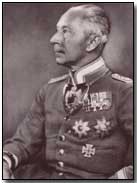Primary Documents - Crown Prince Wilhelm's Assessment of U.S. Troops, 4 September 1918
 First selected as a major
attack target by U.S. commanders in mid-1917, the German-held St. Mihiel
salient was ultimately assaulted by wholly independent U.S. forces on 12
September.
First selected as a major
attack target by U.S. commanders in mid-1917, the German-held St. Mihiel
salient was ultimately assaulted by wholly independent U.S. forces on 12
September.
Although considered an inadvisable and perhaps unnecessary target by U.S. Commander-in-Chief John J. Pershing's fellow Allied commanders - chiefly given the relative inexperience of his forces and the fact that fighting further north had taken precedence - the outcome proved Pershing triumphant. By 16 September the entire German salient had been effectively removed.
Reproduced below is regional commander Crown Prince Wilhelm's assessment of U.S. troops immediately preceding the onset of the battle; click here to read an alternate account he subsequently detailed in his memoirs. Click here to read a summary of the battle by local German commander General Max von Gallwitz. Click here to read Pershing's official summary.
Crown Prince Wilhelm on U.S. Troops, Statement Given to Newspapers on 4 September 1918
Regarding the American forces in France, I've found that the majority don't know what they are fighting for, but we feel, of course, the effect of the entry of the Americans. They have sent over very much material, and are now sending very much human material.
The French fight brilliantly and are bleeding to death. They do not hesitate at any sacrifice. With the English, the individual man is very good and tenacious, but the leadership is deficient.
Among the Americans I have found that the majority do not know what they are fighting for. I asked an American prisoner what they are fighting for and he answered, "For Alsace." Then to the question, "Where is Alsace," he replied, "It's a big lake."
Source: Source Records of the Great War, Vol. VI, ed. Charles F. Horne, National Alumni 1923
An "incendiary shell" is an artillery shell packed with highly flammable material, such as magnesium and phosphorous, intended to start and spread fire when detonated.
- Did you know?
